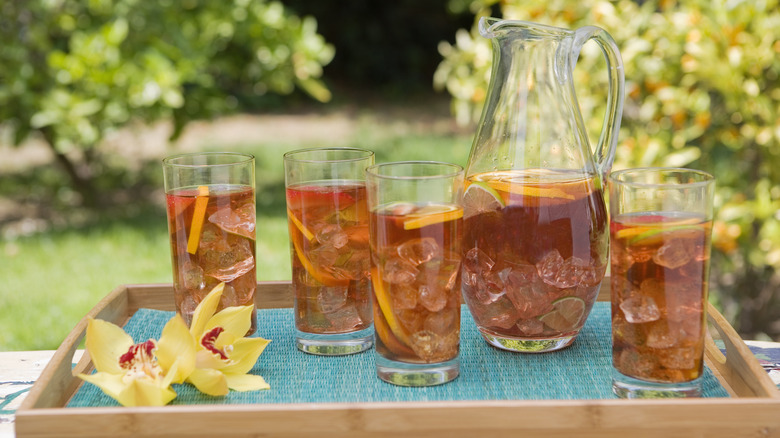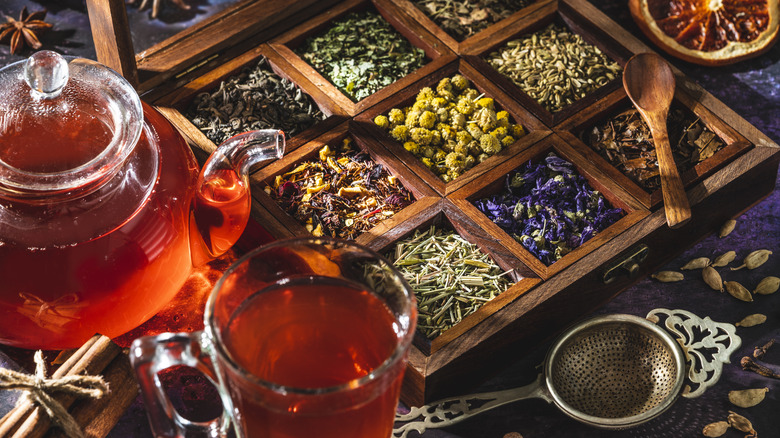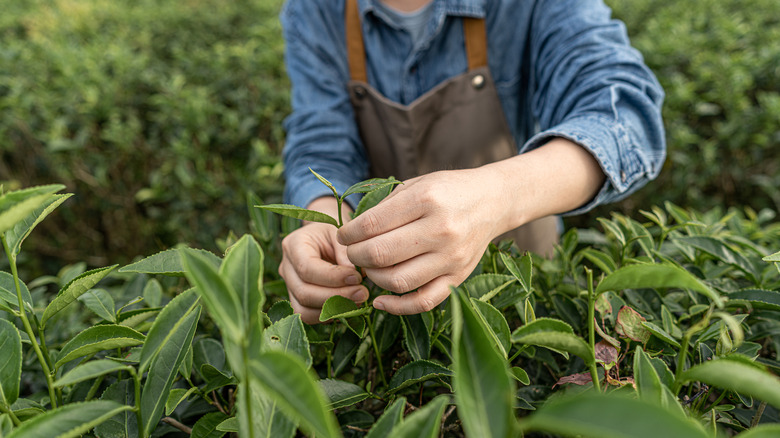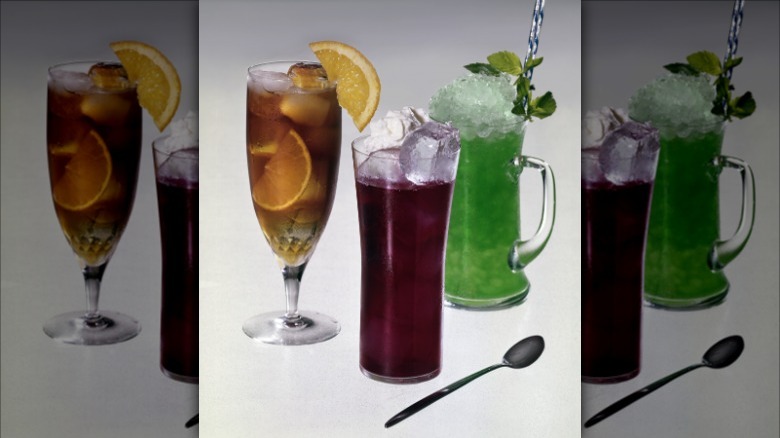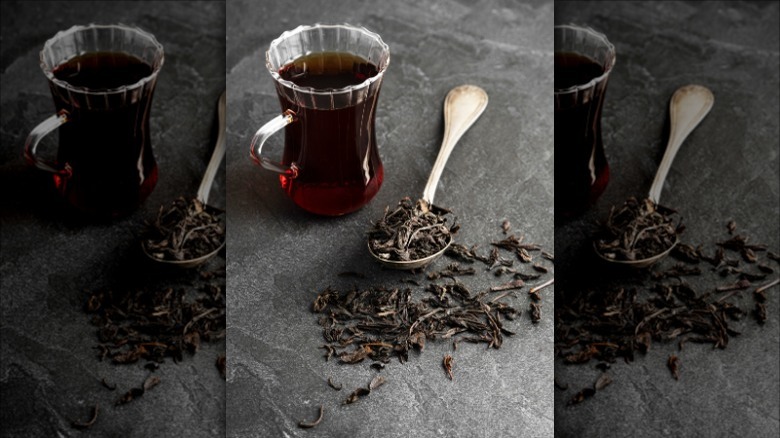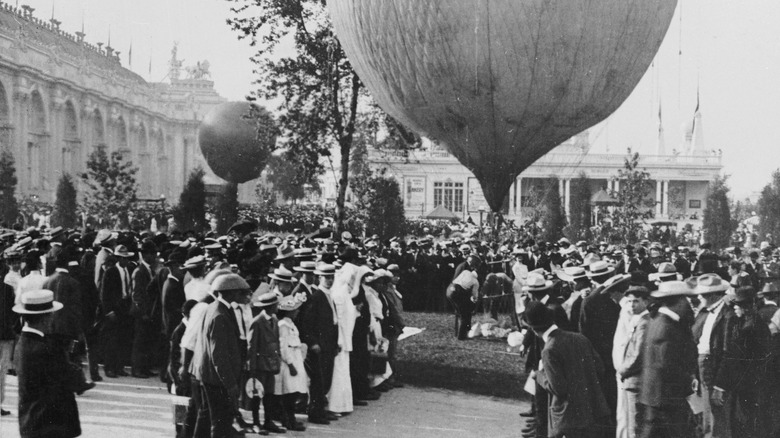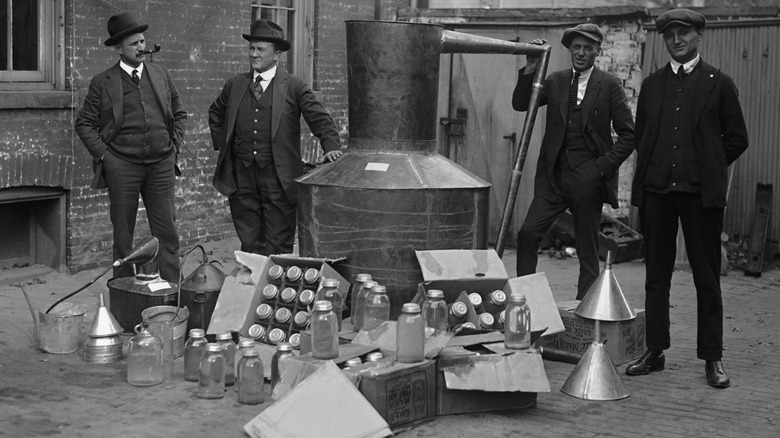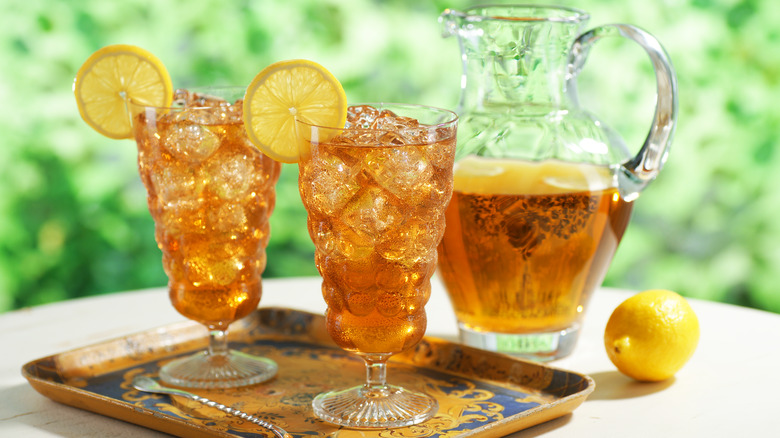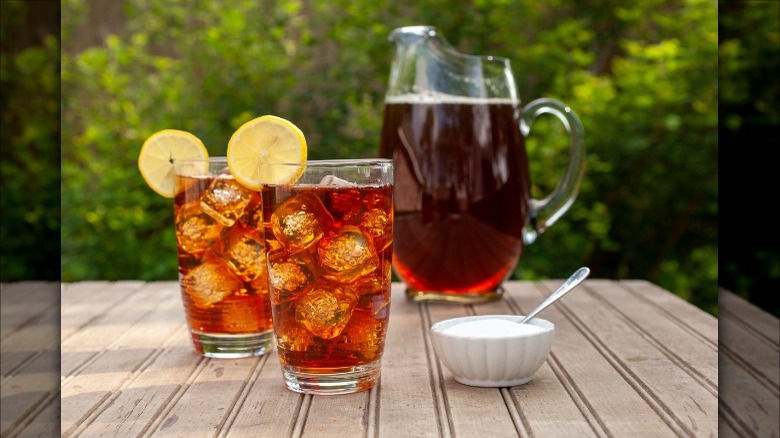The Not-So-Southern Origins Of Sweet Tea
Tea has been consumed for ages in many cultures. As you may know, the ancient history of tea started long ago in China. But it is in America that it went from a hot beverage to an iced summertime drink. Moreover, it is in the South that iced tea became sweet tea, a staple of Southern culture and hospitality. While tea has long been enjoyed, and tea culture has taken hold in several countries, from Japanese tea ceremonies to English tea time, sweet tea is a newer commodity.
Although sweet tea is associated almost entirely with the Southern United States, its origins aren't very Southern at all. In fact, iced tea was invented out of pure ingenuity on a hot summer day in the Midwest, and sweet tea came about as an alternative during the Prohibition era, making the drink much more universal than you'd guess. Until, of course, the South claimed it as their own.
A brief history of how tea reached America
When British settlers first reached the new American colonies in the early 1600s, English tea customs were naturally brought along. It's said that tea itself was introduced in America during the late 1640s by the Dutch. Yet by the time Britain took control of the newly named New York in 1664, tea etiquette modeled that of England. With the British controlling America, it made sense that they would also provide the tea. Hence, the British East India Company maintained its hold on trading tea, supplying the beverage to England and America.
As history has long taught us, the relationship with tea changed drastically in America by the late 1700s. When the drink started to come with a hefty tax, the Boston Tea Party helped carry the spark of the revolution that led to America's independence from Britain. As we know today, this wasn't the end of tea — clearly, we still buy it in bulk on the shelves — but the beginning of a new democracy. With such beginnings, tea also found a different start in America.
Who brought the tea plant to America?
Tea had already been in America, but the tea plant was first brought to America around the late 1700s when French explorer and plant collector, Andre Michaux, debuted it to rich Charleston planters. In a mission devised by the French allies and accepted by America, Michaux's goal was to find new species of trees in America and bring them back to France to rebuild their forests. When he reached South Carolina, which already had some French culture in its cities, Michaux was readily welcomed. In addition to planting a tea plant, he also brought crape myrtle, camellia, and mimosa trees to the States.
Not only was South Carolina the first place in the U.S. where tea was actually grown and not just consumed, but it's also the only state that has mass-produced tea at a large-scale, commercial level. From there, the production of tea took off in America.
Tea has been served cold since the early 19th century
Even though tea was, and is still, often served hot, the drink has been enjoyed cold for over a century. It began with liquor-spiked green tea punches, such as Regent's Punch, named after the English prince regent, George IV. Several variants of cold tea punches made their way through the world. In the mid-nineteenth century, American versions like Charleston's St. Cecilia Punch and Savannah's Chatham Artillery Punch were popular choices. According to What's Cooking America, Lettice Bryanon's cookbook, "The Kentucky Housewife," states that the traditional American tea punch involved brewing tea as usual and then adding sugar, sweet cream, and a bottle of champagne.
While these punches could be enjoyed hot or cold, iced tea's popularity coincides with the commercialization of the ice box or refrigerator. The very first fridge made for homes was invented in 1913 by an American man named Fred W. Wolf, and it had a refrigeration unit on an icebox. Not long after its invention, a new refrigerator created by William C. Durant in 1918 was on the market. Despite being a luxury only some could afford, Americans could finally chill their beverages, leading to the ease of drinks like iced tea.
The first recipe for sweet tea using black tea
While the earliest recipe for sweet tea was recorded in an 1879 cookbook called "Housekeeping in Old Virginia" by Marion Cabell Tyree, the first recipe calling for black tea (which is how it's usually made today) was written by Mrs. D. A. (Mary) Lincoln in 1884, according to What's Cooking America. In the recipe, it actually calls it Ice Tea or Russian Tea. At the turn of the 20th century, black tea was the prime choice for the beverage. This is mainly because it was relatively inexpensive to import from countries like India, Ceylon, South America, and Africa.
Then by World War II, tea was made almost exclusively with black tea. Due to the disturbance of trade between the United States, China, and Japan, green tea was difficult to find. Instead, America was essentially forced to get black tea primarily from British-controlled India. It was easy to procure, and it was the main option the U.S. had, so it became the new norm for the beverage. Almost ironic that centuries after separating from Britain and its tea monopoly, America was pushed back to British-Indian tea producers.
A 1904 World's Fair in St. Louis popularized iced tea
While tea had long been established as a popular beverage, it was in the Midwest that iced tea reached its full potential. As the story goes, Richard Blechynden, the India Tea Commissioner and the Director of the East Indian Pavilion, offered free hot tea at the 1904 World's Fair in St. Louis. But because it was a warm day, he poured the tea into bottles and inverted them on the stands, which gave the tea a way to flow through iced lead pipes. Voila — iced tea without the need for ice was born along with several other American foods we love today. He took this apparatus to NYC, giving his complimentary tea to affluent shoppers at Bloomingdale Brothers Department Store. After this, it became known as a cool and refreshing summertime beverage.
His ingenuity came long before refrigerators and was much quicker than waiting for shipments of ice from the Northern states. Because of his innovative idea, iced tea is believed to have hailed from the Midwest, not the South. Of course, you consider that the tea plant and production came from a Southern state, so perhaps it was a joint effort to give us the drink we love today.
The American Prohibition boosted iced tea's popularity
With the ban on buying, selling, or manufacturing alcohol beginning in 1920, there was a rise in bootlegging and speakeasies. There may be plenty of things you didn't know about Prohibition, and the several options for drinks that didn't contain illegal alcohol are just part of it. So from 1920-1933, iced tea became a regular alternative. And if we had a choice between making "bathtub gin" or iced tea, we're going with the latter.
By this time in history, recipes for sweet tea were often found in Southern cookbooks. In one cookbook, "Southern Cooking," by Georgia native Henrietta Stanley Dull in 1928, the recipe that would become standard for sweet tea in the South was written. Mrs. Dull wrote that "a good blend and grade of black tea is most popular for iced tea, while green and black are used for hot," and explained the process for pre-sweetened tea. As she put it, "less sugar is required if put in while tea is hot, but often too much is made and sweetened, so in the end, there is more often a waste than saving." She set the bar for tea that would be consumed by "church ladies" and other residents of the South for decades.
The difference between iced tea and sweet tea
Iced tea is made with black tea leaves, and sweet tea usually is, too. The main difference comes down to adding sugar and the technique. There are plenty of tips for making the perfect iced tea. There is a tried-and-true process for making authentic sweet tea. To be called such, tea leaves are typically pre-sweetened before brewed. Adding sugar to already brewed tea is just known as sweetened tea, which, differs from classic sweet tea. If you're making it at home, you're likely to just put a heap of sugar in the bottom of the pitcher before brewing hot tea in a tea maker. Although such deviations might not be the traditional method, the main point of sweet vs. sweetened is that the sugar goes first, not last. Finally, as purists will tell you, one ingredient should never go in traditional sweet tea: lemon.
As far as being iced, that just comes down to chilling. Per NPR, New Englanders just took ice from frozen ponds and lakes. In the South, with warmer climates, ice just isn't as common. It wasn't until the nineteenth century that Northern ice entrepreneurs began to ship and sell ice to Southern states. Even then, until transporting the ice began easier, it just didn't come to the South as often. It seemed that most states had to wait until the popularization of home refrigerators in the 1920s to easily have iced beverages such as tea.
How did sweet tea become associated with the South?
Largely because of South Carolina's mass production of tea (to this day!), sweet tea became a staple of the South. Then when the Prohibition era hit the South, people tried to come up with mocktails or beverages, which led to adding sugar and fruit to iced tea for extra sweetness. Adding sugar to iced tea then became a tradition. In a piece by Adrian Miller written for First We Feast in 2016, he argues that "no drink represents Southern culture like sweet tea." Not only does he explain the aesthetic of sweet tea, but also that most sweet tea made outside of the South isn't exactly nailing it. Indeed, when sweet tea is made "correctly," it is the ultimate Southern beverage.
But some Southern regions don't consider it universally of the South. For example, Lolis Eric Elie wrote in "Treme: Stories and Recipes from the Heart of New Orleans," "In New Orleans, sweet tea is not the marker of southern culture that it is in other places." Yet, in other Southern states and cities, the beverage is undoubtedly a cultural staple. So much so that in 1995, South Carolina deemed sweet tea the Official Hospitality Beverage, and in 2003, a Georgia bill (somewhat jokingly) called for every Georgia restaurant to serve only sweet tea if they were to serve tea at all.
